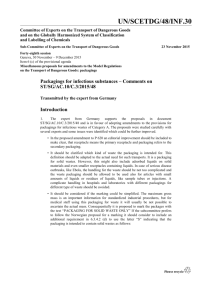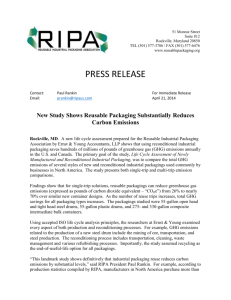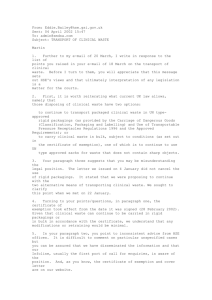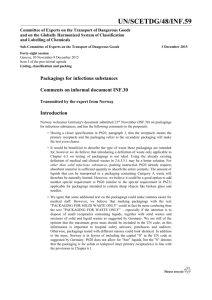LEAK TESTING `UN` APPROVED CONTAINERS
advertisement
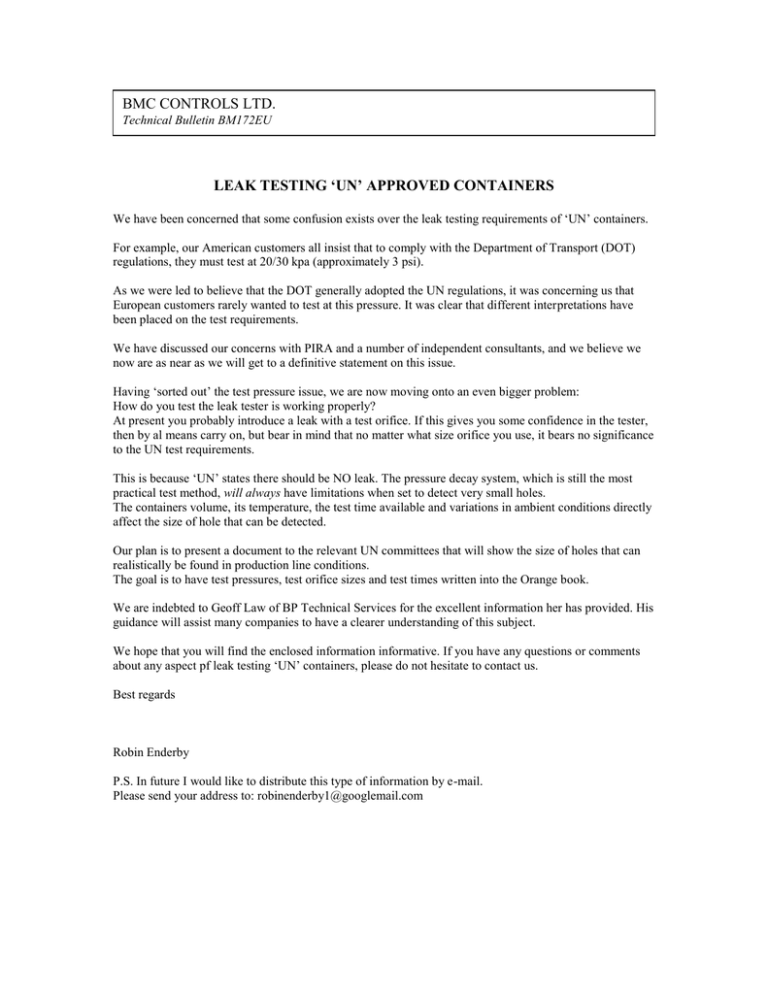
BMC CONTROLS LTD. Technical Bulletin BM172EU LEAK TESTING ‘UN’ APPROVED CONTAINERS We have been concerned that some confusion exists over the leak testing requirements of ‘UN’ containers. For example, our American customers all insist that to comply with the Department of Transport (DOT) regulations, they must test at 20/30 kpa (approximately 3 psi). As we were led to believe that the DOT generally adopted the UN regulations, it was concerning us that European customers rarely wanted to test at this pressure. It was clear that different interpretations have been placed on the test requirements. We have discussed our concerns with PIRA and a number of independent consultants, and we believe we now are as near as we will get to a definitive statement on this issue. Having ‘sorted out’ the test pressure issue, we are now moving onto an even bigger problem: How do you test the leak tester is working properly? At present you probably introduce a leak with a test orifice. If this gives you some confidence in the tester, then by al means carry on, but bear in mind that no matter what size orifice you use, it bears no significance to the UN test requirements. This is because ‘UN’ states there should be NO leak. The pressure decay system, which is still the most practical test method, will always have limitations when set to detect very small holes. The containers volume, its temperature, the test time available and variations in ambient conditions directly affect the size of hole that can be detected. Our plan is to present a document to the relevant UN committees that will show the size of holes that can realistically be found in production line conditions. The goal is to have test pressures, test orifice sizes and test times written into the Orange book. We are indebted to Geoff Law of BP Technical Services for the excellent information her has provided. His guidance will assist many companies to have a clearer understanding of this subject. We hope that you will find the enclosed information informative. If you have any questions or comments about any aspect pf leak testing ‘UN’ containers, please do not hesitate to contact us. Best regards Robin Enderby P.S. In future I would like to distribute this type of information by e-mail. Please send your address to: robinenderby1@googlemail.com BMC CONTROLS LTD. Technical Bulletin BM172EU Leak Testing ‘UN’ Approved Containers It is clear from the UN regulations – see 6.1.1.3 (attached) that it is mandatory for each single package to be tested. However it is not intended that this test in every single package is the Leakproofness test as described in 6.1.5.4.3. This is a ‘Type Test’ for a package design type. However it is easy to see how the two are confused in other regulations e.g. ADR road regulations Appendix A.5.3561 (also attached). The USA DOT 49CFR regulations do appear to specify a minimum pressure for the production testing. This might all be clarified by a CEN / ISO working group which has a work item to develop a standard for Leakproofness testing. This working group (CEN TC261/SC1/WG6 also ISO TC122/SC3/WG8) has been working for a number of years on standardisation of issues relating to dangerous goods packaging testing. One of the issues being addressed is that the UN recommendations are loosely written and subject to variable interpretation. The development of these standards is hoped to lead to a ‘more level playing field’. Good progress has been made on a number of these standards and some, e.g. the Package Testing ISO 16104, which includes the Type Test for Leakproofness testing, are out for public comment. However, the work on ISO 16105 has not started yet! The UK has adopted a hands off approach to this, feeling that the lack of definition here does allow flexibility in the type of leak detection used in production. 6.1.1.3 Every packaging intended to contain liquids shall successfully undergo a suitable leakproofness test, and be capable of meeting the appropriate test level indicated in 6.1.5.4.3: (a) Before it is first used for transport; (b) After remanufacturing or reconditioning, before it is re-used for transport. For this test, packagings need not have their own closures fitted. The inner receptacle of composite packagings may be tested without the outer packaging provided the test results are not affected. This test is not necessary for inner packagings of combination packagings. 6.1.5.4.3 Test method and pressure to be applied: the packagings including their closures shall be restrained under water for 5 minutes while an internal air pressure is applied, the method shall not affect the results of the test. The air pressure (gauge) to be applied shall be: Packaging Group 1 Packaging Group 11 Packaging Group 111 Not less than 30 kPa (0.3 bar) Not less than 20 kPa (0.2 bar) Not less than 20 kPa (0. bar) Other methods at least equally effective may be used. 6.1.5.4.4 Criterion for passing the test: there shall be no leakage 6.1.5.5 Internal pressure (hydraulic) test 6.1.5.5.1 Packaging to be tested: the internal pressure (hydraulic) test shall be carried out on all design types of metal, plastics and composite packagings intended to contain liquids. This test is not required for inner packagings of combination packagings. ADR (Road Transport) regulation 3561 B. Leakproofness test for all new, remanufactured or reconditioned packagings intended to contain liquids. (1) Application of the test Every packaging intended to contain liquids shall successfully undergo a suitable leakproofness test - before it is first used for carriage - After remanufacturing or reconditioning, before it is re-used for carriage. For this test, packagings need not have their own closures fitted. The inner receptacle of composite packagings may be tested without the outer packaging provided the test results are not affected. The test is not required for: (2) - inner packagings of combination packagings; - inner receptacles of composite packagings (glass, porcelain or stoneware) conforming to marginal 3510 (2) - removable head packagings intended for substances with a viscosity at 23 º C exceeding 200mm²/s; - light gauge metal packagings conforming to marginal 3510 (2) Test method: Compressed air shall be introduced through the filling orifice of each packaging. The packaging shall be immersed in water; it shall be kept under water in such a way as not to distort the result of the test. The packaging may also be covered with soap solution, heavy oil or other suitable liquid on its seams or at any other place where leakage occurs. Other methods at least equally effective may also be used. Packagings need not be equipped with their own closures. (3) Air pressure to be applied: Packing group 1 Not less than 30 kPa Packing group 11 Not less than 20 kPa Packing group 111 Not less than 20 kPa 178.604 Leakproofness test. (a) General. The leakproofness test must be performed with compressed air or other suitable gases on all packagings intended to contain liquids, except that: (1) The inner receptacle of a composite packaging may be tested without the outer packaging provided the test results are not affected; and (2) This test is not required for inner packagings of combination packagings. (b) Number of packagings to be tested(1) Production testing. All packagings subject to the provisions of this section must be tested and must pass the leakproofness test: (i) Before they are first used in production (ii) Prior to reuse, when authorized for reuse by 173.28 of this subchapter. (2) Design qualification and periodic testing. Three samples of each different packaging must be tested and must pass the leakproofness test. Exceptions for the number of samples used in conduction the leakproofness test are subject to the approval of the Associate Administrator for Hazardous Materials Safety. (c) Special preparation – (1) For design qualification and periodic testing, packagings must be tested with closures in place. For production testing, packagings need not have their closures in place. Removable heads need not be installed during production testing. (2) For testing with closures in place, vented closures must either be replaced by similar non-vented closures or the vent must be sealed. (d) Test method. The packaging must be restrained under water while an internal air pressure is applied; the method of restraint must not affect the results of the test. The test must be conducted for other than production testing, for a minimum time of five minutes. Other methods, at least equally effective, may be used in accordance with Appendix B of this part. (e) Pressure applied. An internal air pressure (gauge) must be applied to the packaging as indicated in the following packing groups: (1) Packing Group 1: Not less than 30 kPa (4 psi) (2) Packing Group 11: Not less than 20 kPa (3psi) (3) Packing Group 111: (Not less than 20 kPa (3psi) (f) Criteria for passing the test. A packaging passes the test if there is no leakage from the packaging. 178.605 (a) General. One hydrostatic pressure test must be conducted for the qualification of all metal, plastic, and composite packaging design types intended to contain liquids and be performed periodically as specified in 178.601(e). This test is not required for inner packagings of combination packagings. For internal pressure requirements for inner packaging of combination packagings intended for transportation by aircraft, see 173.27(c) of this subchapter. (b) Number of test samples. Three test samples are required for each different packaging. For packagings constructed of stainless steel, monel, or nickel, only one sample is required for periodic retesting of packagings. Exceptions for the number of aluminium and steel sample packagings used in conducting the hydrostatic pressure test are subject to the approval of the Associate Administrator for Hazardous Materials Safety. (c) Special preparation of receptacles for testings, Vented closures must either be replaced by similar non-vented closures or the vent must be sealed. (d) Test method and pressure to be applied. Metal packagings and composite packagings other than plastic (e.g., glass. Porcelain or stoneware), including their closures must be subjected to the pressure test for 5 minutes. Plastic packagings and composite packagings (plastic material), including their closures must be subjected to the test Page 792
